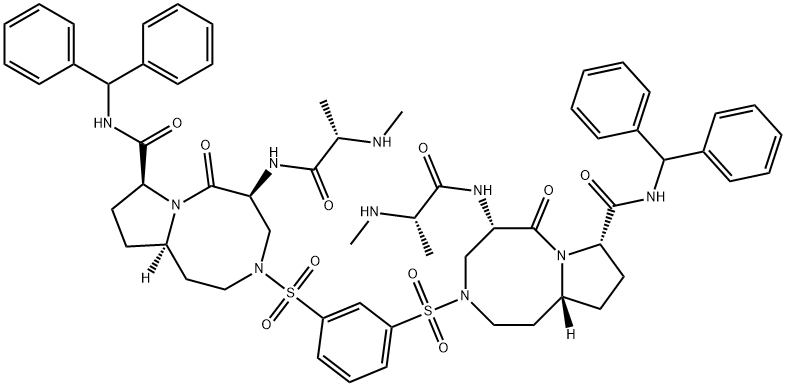All AbMole products are for research use only, cannot be used for human consumption.

For this product's availability, delivery time and price, please email [email protected] directly or click the "Inquiry Now" button below.
APG-1387 is a divalent SMAC mimetic that is an IAP antagonist that blocks the activity of the IAP family of proteins (XIAP, cIAP-1, cIAP-2, and ML-IAP). APG-1387 induces degradation of cIAP-1 and XIAP proteins as well as caspase-3 activation and PARP lysis, leading to apoptosis. APG-1387 can be used for the study of hepatocellular carcinoma, ovarian cancer and nasopharyngeal carcinoma.
| Molecular Weight | 1157.4 |
| Formula | C60H72N10O10S2 |
| CAS Number | 1570231-89-8 |
| Solubility (25°C) | DMSO ≥ 20 mg/mL |
| Storage |
Powder -20°C 3 years ; 4°C 2 years In solvent -80°C 6 months ; -20°C 1 month |
| Related IAP Products |
|---|
| AZD5582 dihydrochloride
AZD5582 dihydrochloride is an antagonist of the inhibitor of apoptosis proteins (IAPs), which binds to the BIR3 domains cIAP1, cIAP2, and XIAP with IC50s of 15, 21, and 15 nM, respectively. |
| Sanggenon G
Sanggenon G is a cell-permeable and potent inhibitor of X-linked inhibitor of apoptosis protein (XIAP). |
| TD-1092
TD-1092 is a pan-inhibitor of apoptosis (IAP) degrader with two different types of E3 ligase conjugates, IAP and CRBN, that induces proteasomal degradation of cIAP2 and XIAP in a CRBN-dependent manner. TD1092 also activates apoptotic proteases (apoptosis 3/7) and leads to apoptosis by promoting IAP degradation. In addition, TD1092 also blocks the TNFα-mediated NF-κB signaling pathway and inhibits the phosphorylation of IKK, IkBα, p65, and p38. TD1092 can be used as a PROTAC for cancer research. |
| LBW242
LBW242, a 3-mer and Smac mimetic, is a potent and orally active proapoptotic IAP inhibitor. LBW242 shows effects on mutant FLT3-expressing cells. LBW242 has activity against multiple myeloma, and potentiates TRAIL- and anticancer agent-mediated cell death of ovarian cancer cells. |
| UC-112
UC-112 is a novel potent IAP(Inhibitor of apoptosis) inhibitor. UC-112 potently inhibit cell growth in two human melanoma (A375 and M14) and two human prostate (PC-3 and DU145) cancer cell lines(IC50=0.7-3.4 uM). |
All AbMole products are for research use only, cannot be used for human consumption or veterinary use. We do not provide products or services to individuals. Please comply with the intended use and do not use AbMole products for any other purpose.


Products are for research use only. Not for human use. We do not sell to patients.
© Copyright 2010-2024 AbMole BioScience. All Rights Reserved.
